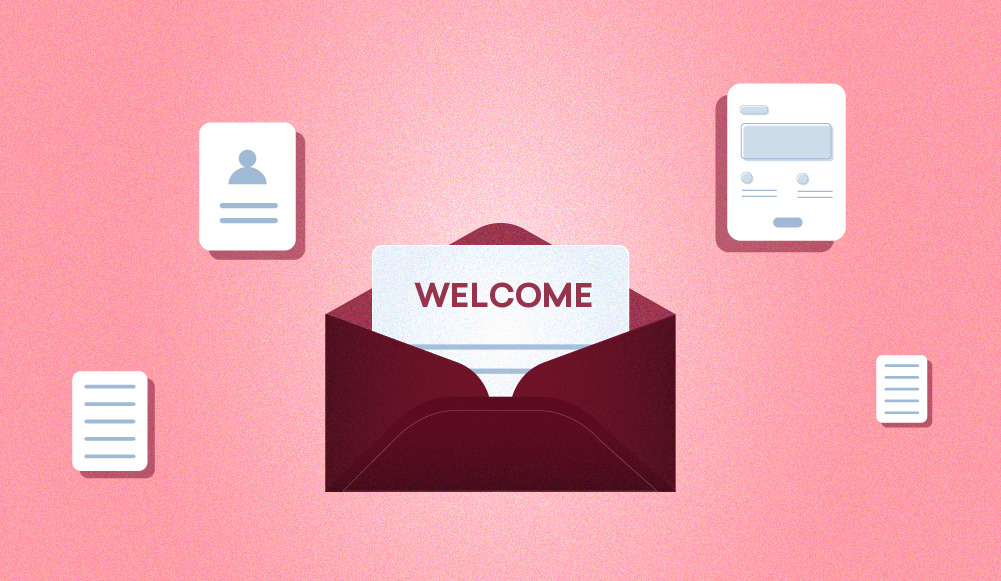The Simplest and Most Effective Way to Onboard New Hires

One of the most searched-for questions on the internet during the pandemic has been “how to onboard new hires remotely?” This is a difficult task to carry out, especially when it comes to giving new hires a sense of belonging. But what if we told you that most of your remote onboarding problems could be solved by simply writing good emails?
Well-written employee onboarding emails can shoot down hundreds of questions even before they are asked. They can make your new hires feel safe, welcome, and confident.
You can either approach welcome emails as a chore to get done or as a strategic opportunity to:
- Improve your onboarding completion rates.
- Offer an impeccable employee experience starting from Day 0.
- Shorten your new hire’s time to productivity.
- Reduce post-offer dropouts (especially during remote onboarding periods).
At first, writing thoughtful emails to your new employees can feel overwhelming. It may even look impossible because there are so many emails to write to so many new employees. However, with smart onboarding software like Freshteam, you can create reusable email templates and use built-in placeholders to personalize your messages.
You can also put together a reusable onboarding kit with all the required forms to fill, handbooks, and documents to sign. You can send every new hire the kit in a single click. That’s one kit in place of 15 or 20 emails.
Let’s look at some best practices you can use to get these initial email communications right.
8 Tips to Write Successful Employee Onboarding Emails
- Use an impressive subject line: Make your company name a part of the subject line, because many new employees may not have official email accounts and may be using their personal accounts to communicate with you. If your subject line does not get right to the point, they may miss your message.
- Keep it easy to read: Share details, clarify common doubts, and keep the emails easy to read. You can highlight important parts like times, places, or dates. Use a list wherever possible and keep sentences short. Many employees may access onboarding emails via their phones, so content needs to be digestible.
- Be welcoming: Be warm and personal so you can prompt a sense of belonging and joy in each new hire right away. Choose a tone that reflects the nature of your employer brand and company culture.
- Create clear and visible calls to action: Show your new employees what to do next: fill out the form, submit the documents, show up at work, etc.
- Include links to employees’ social profiles: If you are introducing people over email — for example, a new hire’s manager or buddy — make sure you add links to their social profiles or blogs. This will help your new hires initiate conversations with their new colleagues more confidently.
- Proofread: Proofread. Proofread. If necessary, use a tool like Grammarly to ensure your emails don’t contain any typos or mistakes that make you look careless.
- Introduce an active communication channel: Give new hires a way to start engaging with their teams right away. It could be your company forum, a Slack channel, or any other platform where your employees are quick to respond.
- Make an action plan: Lay out simple and understandable onboarding plans for the new hire’s first day, first week, and first month. You could also break each stage down into achievable goals so the employee knows what they are going to be doing without ambiguity. Goals can include things like “complete your profile on the self-service portal,” “complete the network security training,” etc.
If you would like some sample email templates that demonstrate these tips in action, check out this new employee email repository from Freshteam.
Wrapping Up
Employee onboarding directly impacts the employee life cycle: employee experience, employee engagement, employee performance, and employee retention. Because of this, onboarding is key to business success. Your onboarding emails to new hires are your biggest opportunity to influence their onboarding experience positively.
Creating, managing, and tracking email communication can be tedious without the right tools. It’s impossible to manually schedule, track performance, and follow up on hundreds of emails. On the other hand, a good onboarding software empowers you to be efficient and organized. You can use canned email templates, schedule email campaigns, track responses, and send one-click follow-ups.
Great onboarding software also comes with onboarding checklists that enable you to create, assign, and track every item that is part of the onboarding process in one place. For example, form completions can be assigned to a candidate, network credentials setup can be assigned to the IT team, sending out welcome emails can be assigned to the HR team, and so on.
It’s the best way to drive your employee onboarding success rates to 100 percent.
About Freshteam
Freshteam is smart HR software that enables recruiters to attract, hire, and onboard top talent from the industry. On the onboarding front, it helps streamline and improve your new hires’ onboarding experience with onboarding kits, checklists, digital signatures, employee self-service, and more. If you are looking for good onboarding software, try Freshteam. If you are interested in trying Freshteam’s HR software for free, sign up here.
This article by Freshteam is built on the original article that first appeared on the Freshteam blog.
Recruiter.com regularly features reviews, articles, and press releases from leading businesses. This featured article may include paid promotion or affiliate links. Please make every effort to perform due diligence when selecting products and services for your business or investment needs and compare information from a variety of sources. Use this article for general and informational purposes only.

